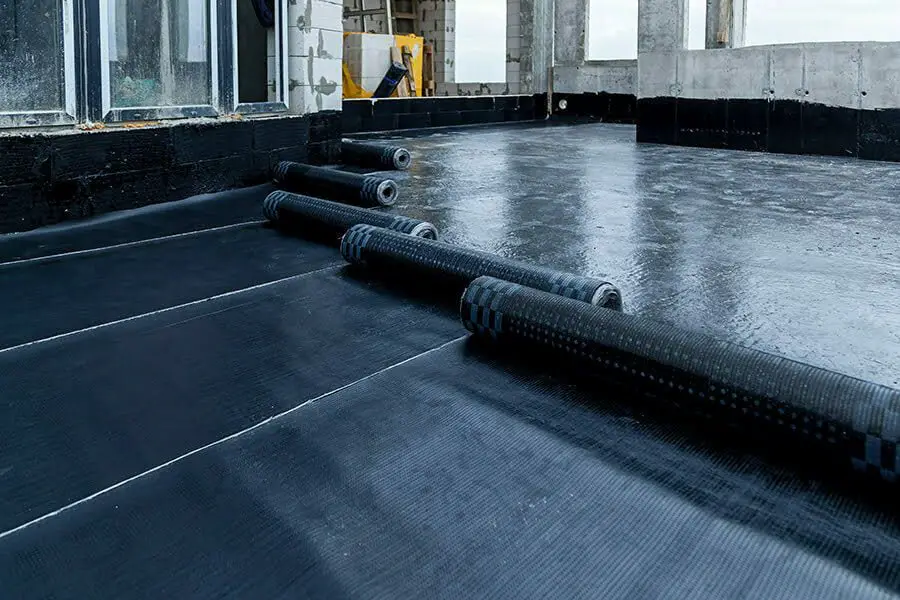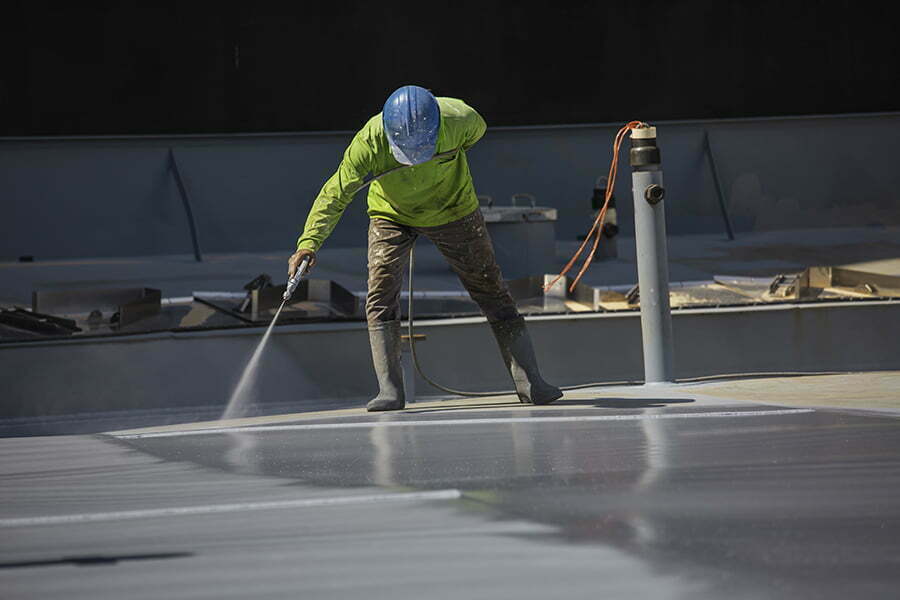Yes, polymers can be used in roofing and waterproofing applications.
Polymers are an incredibly versatile material that can be used in various applications. One area where they have become increasingly popular is in roofing and waterproofing applications.
Polymers offer several advantages over traditional materials, including increased durability, flexibility, and cost-effectiveness. This blog post will explore how polymers can be used in roofing and waterproofing applications and the benefits they provide.
Key takeaways:
- Polymers can be used as roofing membranes.
- Polymers are used to create waterproof coatings.
- Polymers are used as sealants in roofing and waterproofing.
- Polymers act as adhesives in roofing and waterproofing.
- Polymers offer durability, sustainability, and innovative applications in construction.
Roofing Membranes

Roofing membranes are a type of waterproofing material made from polymers. They are typically used to protect roofs from water damage and other environmental elements.
The membrane is applied directly to the roof deck, providing a barrier between the roof and any moisture that may be present in the environment. Roofing membranes can also provide additional insulation, helping keep buildings cooler in hot and cold climates.
Polymer-based roofing membranes are lightweight, durable, and easy to install, making them an ideal choice for many roofs.
Waterproof Coatings

Polymers can be used to create waterproof coatings for roofing and waterproofing applications. These coatings are applied as a liquid or spray, forming a protective layer over the surface of the material being treated.
This layer is designed to repel water, preventing it from seeping into the material underneath. The polymer coating also helps protect against UV rays, wind, and other environmental factors that could cause damage to the roof or other surfaces.
Polymer coatings can be used on metal roofs, asphalt shingles, wood shakes, concrete tiles, and many other materials. They provide an effective barrier against water infiltration while allowing air circulation beneath the surface of the treated material.
Sealants
Sealants are a type of polymer used in roofing and waterproofing applications. They are typically applied as a liquid or paste and then allowed to dry and harden into a solid form.
Sealants are an effective barrier against water, air, dust, dirt, and other contaminants. They also help prevent mold and mildew growth on roofs by creating an impermeable layer that prevents moisture from entering the structure.
Sealants come in many different types, such as acrylics, silicones, polyurethanes, epoxies, latexes, and more, each with unique properties for specific applications. For example, silicone sealant is often used for waterproofing because it is highly resistant to temperature extremes.
Meanwhile, the acrylic sealant is better suited for sealing gaps around windows or doors due to its flexibility when exposed to movement or vibration.
Adhesives
Polymers are a type of material that can be used in roofing and waterproofing applications. One way they can be used is as adhesives, which help bond two surfaces together.
Polymer adhesives are often used to attach roofing materials such as shingles or tiles to the underlying structure of a building. They provide strong bonds between the different components, helping them stay securely attached even when exposed to extreme weather conditions.
Polymer adhesives can also be used for waterproofing applications by sealing gaps between different parts of a building’s structure, preventing water from entering and causing damage.
Comparing Different Types of Polymer Roofing Membranes
When it comes to polymer roofing membranes, there are several different types available on the market. Each type has its own unique characteristics and advantages.
One common type is thermoplastic olefin (TPO) roofing membrane, which is known for its durability and resistance to UV radiation. TPO membranes are also highly reflective, helping to reduce energy costs by keeping buildings cooler.
Another popular option is ethylene propylene diene monomer (EPDM) roofing membrane. EPDM membranes are made from a synthetic rubber material that offers excellent weather resistance and flexibility.
They can withstand extreme temperatures without cracking or deteriorating over time.
Polyvinyl chloride (PVC) roofing membranes provide exceptional chemical resistance and fire retardancy properties. PVC roofs have a long lifespan and require minimal maintenance, making them an attractive choice for many building owners.
Lastly, there are modified bitumen polymer-based roofing systems that combine the benefits of traditional asphalt with added polymers for enhanced performance in terms of strength, flexibility, and durability.
Durability and Maintenance Expectations of Polymer-Based Waterproof Coatings
These coatings are designed to withstand harsh weather conditions, UV radiation, and chemical exposure without deteriorating or losing their protective properties.
One of the key advantages of polymer-based waterproof coatings is their long lifespan. They can provide reliable protection against water infiltration for many years, ensuring the integrity of structures such as roofs and foundations.
Unlike traditional materials like asphalt or concrete that may crack over time due to temperature fluctuations or settling ground, polymer coatings remain flexible and resistant to cracking.
Maintenance requirements for polymer-based waterproof coatings are typically low compared to other options. Regular inspections should be conducted to identify any signs of damage or wear but generally speaking these types of coating systems do not need frequent repairs or reapplications unless there is significant damage caused by external factors.
To maximize the longevity and performance of these coatings it’s important that they are applied correctly according to manufacturer guidelines by trained professionals who have experience with this type application process in order ensure proper adhesion between the coating material itself as well as substrate being coated (e.g., roof surface).
Environmental Impact and Sustainability of Polymer Construction Materials
These materials are often more sustainable compared to traditional alternatives. One reason is that polymers can be recycled and reused, reducing the amount of waste generated during construction projects.
Some polymer products are made from renewable resources or incorporate recycled content, further minimizing their carbon footprint.
Furthermore, polymers offer excellent durability and longevity in roofing and waterproofing applications. This means that structures using polymer-based materials require less frequent replacement or repair compared to other options.
By extending the lifespan of buildings and infrastructure, polymers contribute to reduced resource consumption over time.
Moreover, many polymer coatings used in roofing and waterproofing applications have reflective properties that help reduce energy consumption by reflecting sunlight away from buildings. This can lead to lower cooling costs during hot summer months.
It’s worth noting that advancements in technology continue to improve the sustainability profile of polymer construction materials even further. Researchers are exploring ways to develop biodegradable polymers with similar performance characteristics as conventional ones.
Innovative Applications of Polymers in Roofing and Waterproofing
They offer a wide range of innovative applications that enhance performance, durability, and sustainability.
One such application is the use of polymer-based roof coatings. These coatings provide an effective barrier against water infiltration while also offering excellent UV resistance.
They can be applied to various roofing materials like metal, concrete, or asphalt shingles to extend their lifespan by protecting them from weather damage.
Another innovative use is polymer-modified bitumen membranes for flat roofs. By incorporating polymers into traditional bitumen materials, these membranes gain enhanced flexibility, strength, and resistance to temperature fluctuations.
This makes them less prone to cracking or splitting over time compared to conventional bitumen roofs.
Polymer composite panels are yet another exciting development in roofing systems. These lightweight panels consist of a core material sandwiched between two layers made from reinforced polymers or fiberglass sheets bonded together using advanced adhesives.
The result is a highly durable yet lightweight panel that offers excellent thermal insulation properties while being resistant to moisture penetration.
Furthermore, advancements in polymer technology have led to the development of self-healing roof membranes capable of repairing small cracks on their own through chemical reactions triggered by external factors like heat or moisture exposure.
Lastly but not leastly (if applicable), green roofs are gaining popularity as an eco-friendly solution for urban areas where space is limited but environmental benefits are desired. Polymer-based waterproofing systems play a crucial role here by providing reliable protection against leaks while allowing proper drainage for vegetation growth on rooftops.
These examples highlight just some innovative ways polymers are transforming the roofing and waterproofing industry today – improving performance characteristics such as durability, energy efficiency, and sustainability.
Potential Drawbacks of Polymer Use in Construction and Ways to Mitigate Them
One common concern is the environmental impact of polymer materials. Some polymers are derived from non-renewable resources and can contribute to pollution during production and disposal.
However, this issue can be mitigated by using recycled or bio-based polymers that have a lower carbon footprint.
Another drawback is the potential for degradation over time due to exposure to UV radiation or harsh weather conditions. To address this, manufacturers have developed polymer formulations with enhanced UV resistance and durability.
Regular maintenance and inspections can help identify any signs of deterioration early on so that necessary repairs or replacements can be made promptly.
Cost is another factor that may deter some builders from using polymers extensively in construction projects. While initial costs may be higher compared to traditional materials like asphalt or concrete, it’s important to consider the long-term savings associated with reduced maintenance requirements and increased lifespan offered by polymer solutions.
Lastly, proper installation techniques are crucial when working with polymer roofing membranes or waterproof coatings as improper application could lead to leaks or other issues down the line. By ensuring trained professionals handle installation according to manufacturer guidelines, these risks can be minimized significantly.
While there are certain drawbacks associated with using polymers in construction applications such as roofing and waterproofing systems; advancements in technology continue addressing these concerns effectively through sustainable sourcing options; improved durability against environmental factors; cost-benefit analysis considering long-term savings; along with proper installation practices being followed diligently.
FAQ
What polymer is used in roofing?
The polymer used in roofing is polypropylene.
What is polymer waterproofing?
Polymer waterproofing is the use of polymer-based solutions, offering adhesion and durability, for the purpose of waterproofing material, particularly in concrete and masonry structures.
What is a polymer bitumen membrane?
A polymer bitumen membrane is a material predominantly used for waterproofing structures like foundations, roads, bridge decks, and flat roofs, and can also act as an underlay for pitched roofs and as a vapor barrier.
What is elastomeric emulsion?
Elastomeric emulsion is a type of hybrid polymer mixture that exhibits properties like high tensile strength, toughness, low dirt accumulation, and in some instances, suitability for continuous underwater immersion.
How are polymer materials utilized in the insulation of buildings?
Polymer materials in building insulation are used due to their high resistance to thermal conductivity, effectively reducing energy consumption and improving indoor comfort by regulating temperature.
Can you discuss the advantages of polyvinyl chloride (PVC) in window construction?
Polyvinyl chloride (PVC) in window construction offers several advantages such as low cost, efficient energy conservation, high durability, and ease of maintenance.
In what ways does polymeric sand contribute to the durability of paver installations?
Polymeric sand enhances the durability of paver installations by binding and sealing the pavers together, which prevents erosion, deters weed growth, and resists insect penetration.
Recap




